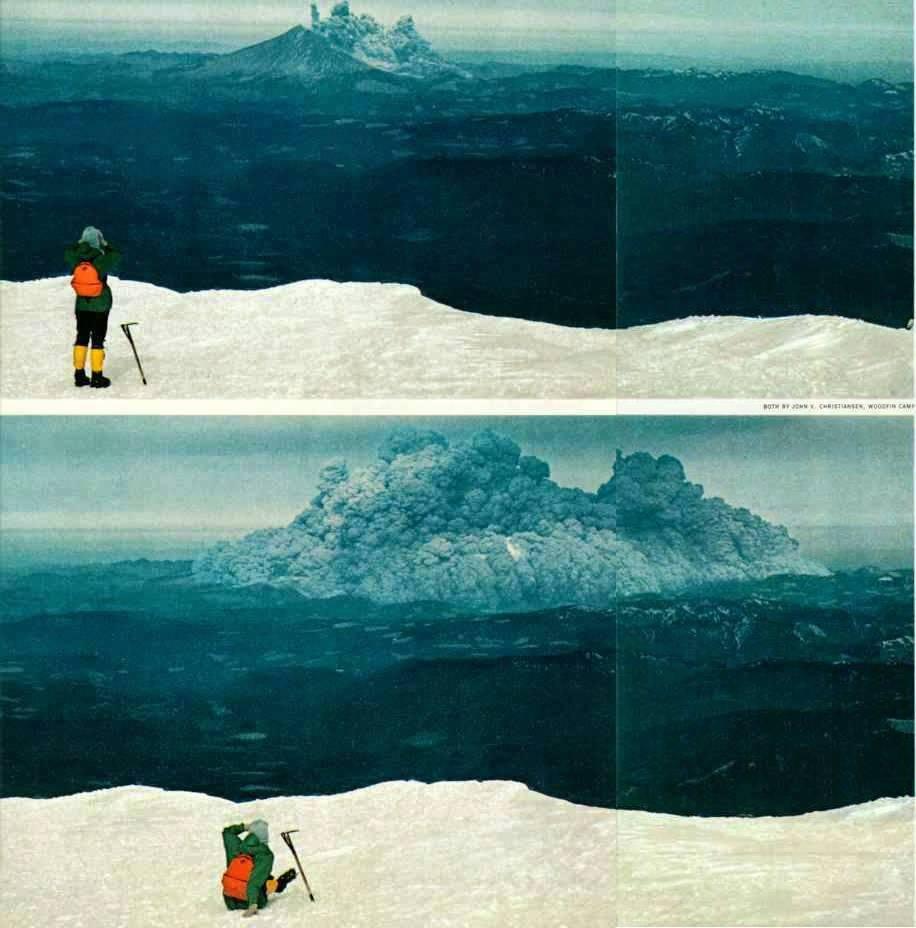(mm 2243.7) The mountain you are standing on last erupted only 1000 years ago but is currently sleeping deeply.
Twenty nine miles west of you is the crater of the youngest active stratovolcano in the Cascades, Mount Saint Helens. Whatever weather you are experiencing today, people standing where you are on May 18th, 1980, had it a lot worse starting at 8:32 AM when the 24 megaton eruption occurred. Anyone standing here then would not feel the initial blast but might be challenged to survive the downpour of ash, pumice, and glass shards carried directly toward them by the prevailing winds that morning.
The lateral eruption, triggered by a magnitude 5.1 earthquake, blew out the north side of the mountain reducing its peak elevation from 9,677 to 8,363 ft and leaving a one mile wide horseshoe-shaped crater. Superheated gasses traveling near the speed of sound blasted away every tree, vaporized lakes, and killed every animal within an 8 mile radius of the crater. Depending on topography, from 8 to 19 miles from the crater trees were striped of leaves and branches, and trunks were broken off at the ground pointing in the direction of the blast. Beyond that, some trees were left standing but were singed by the hot gasses. The pyroclastic flows that raced down the valleys were as hot as 680 F.
The eruption released >1.5 million tons of sulfur dioxide into the atmosphere. The ash plume erupted for more than nine hours and reached an atmospheric elevation of 12 miles above sea level. The particles charged the atmosphere causing lightning that started multiple wildfires that day. The plume moved east, and slightly north, directly toward your location, at 60 mph. Cars were dusted with ash as far away as Edmonton Canada. By about 5:30 PM the ash plume declined in size and the city of Yakima was left buried under 4-5 inches of ash.
In total, the eruption killed fifty-seven people, destroyed 200 homes, 47 bridges, 15 miles of railway, and 185 miles of highway. Additional people died in traffic accidents caused by low visibility. The most famous series of photos of the event were taken 10.7 miles from the crater at Bear Meadow Viewpoint by Gary Rosenquist. When Gary realized he would not make it out, he put his camera in his backpack and laid on it to protect the film with his body.
After its 1980 eruption, the volcano experienced continuous volcanic activity until 2008. Geologists predict that future eruptions will be more destructive, as the configuration of the lava domes requires more pressure to erupt. However, Mount St. Helens is now the best monitored volcano in the world with 25 seismic stations and 20 GPS stations. It's a popular hiking spot and it is climbed year-round. President Jimmy Carter visited the area after the eruption and in 1982, the Mount St. Helens National Volcanic Monument was established by President Ronald Reagan and the U.S. Congress.
An eruption in 1800 was likely greater in force that the 1980 eruption, but was vertical, not lateral, so did not destroy the cone and did less damage. There were smaller eruptions of ash in 1831, 1842, and 1857.


 Photo: Climbers on Mt Adams watch Mt Saint Helens erupt
Photo: Climbers on Mt Adams watch Mt Saint Helens erupt
